After posting this exuberant flower embroidery pattern a couple weeks ago, and this openwork flower embroidery pattern last week, I received some questions from readers about old needlework catalogs and gleaning patterns from them.
So I pulled out my copy of the old Herrschner’s catalog from the first decade of the 1900’s to illustrate some points on developing line drawings that are suitable for hand embroidery patterns.
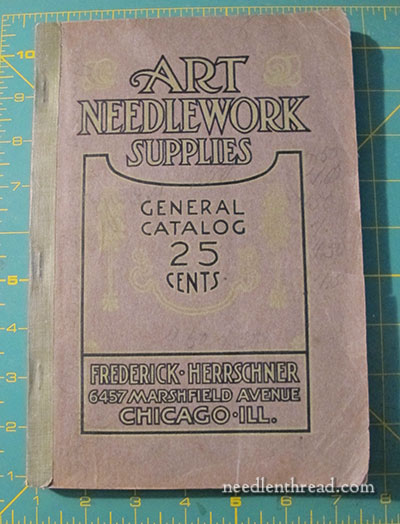
This is the catalog. You can see that it is not very large at all – about 6.5″ x 9.5″, and about 1/2″ thick. Considering that the catalog features hundreds and hundreds of designs for needlework sold by Herrschner’s at that time, you can imagine that the designs actually featured in the catalog are very, very small.
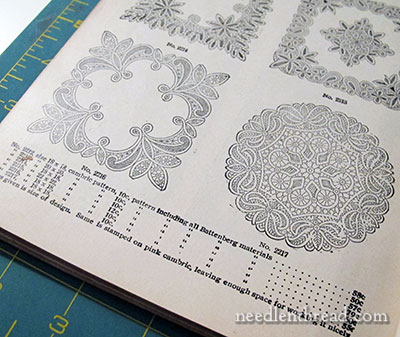
Here are some of the Battenburg lace designs in the catalog. They’re great designs! And, for being so small, the details on them are quite clear. The largest pattern shown above (the one on the left) is about 2″ x 2″, representing a tea cloth or table cloth or doily pattern that could be ordered for an 18″ x 18″ cloth or 22″ x 22″ cloth.
So, the pattern as shown in the catalog is significantly reduced in size, yet it retains enough clarity for the embroiderer to discern whether or not the pattern is palatable.
The patterns are not actually presented full size, or anything close to full size. For 30 cents, the embroiderer ordered a full-sized, perforated pattern ready to transfer onto fabric.
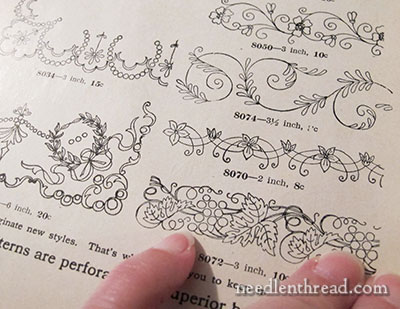
Other designs – borders for tea cloths or for household linens – are equally as small in size. Underneath the border is indicated what size the pattern actually is, in depth. So the grape design just above my fingers in the photo above, is about 1/2″ high in the catalog, but it represents a design that, when purchased, was three inches deep.
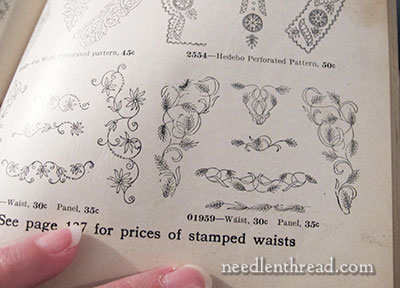
Again, here are some teeny tiny patterns, this time for the elements of embroidered shirt waists. Now, the embroiderer could order the perforated patterns and transfer them onto her own fabric, or she could order the patterns already stamped onto fabric, ready to embroider and then cut out and sew up into a wearable garment.
In any case, the pattern representations shown in the catalog are very, very small.
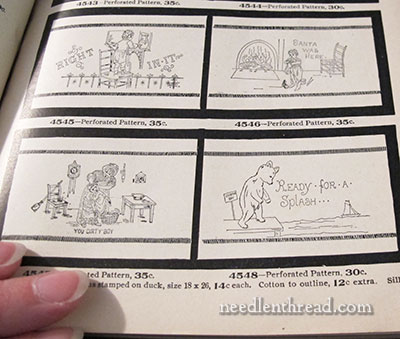
Here, again, are some tiny designs for “splashers” (hangings for behind the sink or tub area, where a child was bathed). They’re not large enough to reproduce, as is, into a piece of embroidery (unless it’s a miniature piece of embroidery).
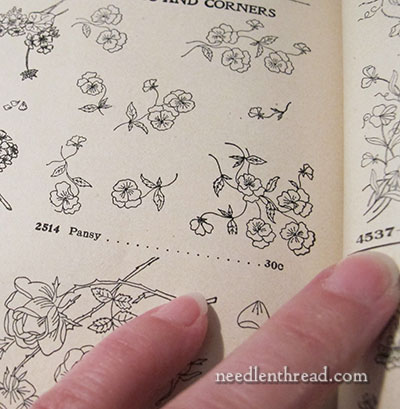
And here’s a group of tiny pansy sprays, for handkerchiefs, tea towels, or the like, depending on how the embroiderer wanted to use them.
When providing a pattern here on Needle ‘n Thread, it would be quite useless to offer you a design that’s the same size as the designs in the actual catalog. Unless you’re into painstakingly small embroidery, what would you ever do with them?
So instead, when I see something in a catalog that strikes me as a good design to share – something that I think others might like to stitch into something fun – I go about reproducing it in a larger size.
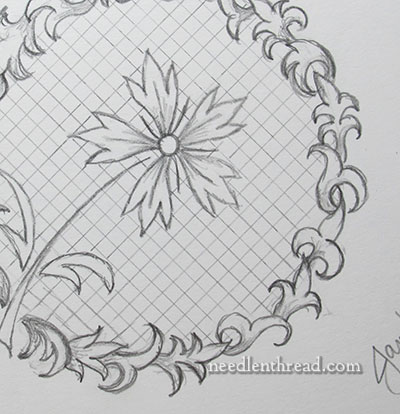
Sometimes, I might incorporate the element into a sketch. And then, as the sketch develops closer to something I like better, I’ll scan it and turn it into a vector drawing (which is not necessarily a quick process!).
Other times, I might see a design in a catalog, and focusing on one element of the design (like I did with this Exuberant Flower embroidery pattern), I’ll just scan the design from the catalog in a high resolution, crop it, and then reproduce the element as a vector image.
About Vector Images
A vector image, for those who don’t know, is a drawing done on the computer, to create a smooth-lined image that can be enlarged or reduced without losing clarity.
Adobe Illustrator is probably the best-known professional program for creating vector images, but it is quite expensive. Inkscape is a share-ware program that you can download for free that also is used to create vectors, and it’s probably the easier of the two to learn, especially if you don’t have other experience with Adobe products.
I use both interchangeably, as they both have different features that I like. There are some things I like to do in Illustrator that I don’t like doing in Inkscape, and some things in Inkscape that I think are done more easily and quickly than in Illustrator.
It Still Takes Time
When it comes to turning a design into a vector image, it is not done magically by clicking a button or two. Although there are “trace” options in vector-producing software, they rarely (if ever!) supply a perfectly finished image.
Vector vs. Sketch
I like sketching out my design ideas, and whenever I’m about to embark on a large project, I always sketch first, and I use colored pencils or water colors to work out color schemes.
But when I put a free pattern on the website, I put it on as a clean line image (a vector image, saved as a PDF for easy printing) rather than a sketch, because I figure that, if you want to use an image as an embroidery design, you don’t want a messy sketch. You want clean lines, right?
I hope this helps answer some of your questions about producing individual embroidery patterns from old catalogs. If you have any other questions, though, I’m all ears! Feel free to ask below!







Thanks for this Mary. I always wondered how this was accomplished. Looks as if I just may have to learn Illustrator!
G’day Mary,
Thank you for this Mary. As ever, it’s not just informative but interesting and most enjoyable. Cheers, Kath
Hello, Mary.
Thank you for (yet another!) interesting and informative post! I always learn so much from you. Thank you for this.
The Herrschner’s catalogue you shared prompted me to look at their website. It shows the covers of several early catalogues- a far cry from the ones I receive now! I didn’t know that they’re originally from Chicago; thought that they had started here in Wisconsin.
Thanks again , Mary. You’re a great teacher!
This was wonderful. You mentioned in an earlier article that the Herrschner catalogs of years ago were quite different than those we get today. Wow, are they different. Now we get photos of finished items, often set at an angle to look pretty. But back in the old days, they didn’t have to worry about someone scanning and enlarging their drawings, thus losing a sale.
It would be interesting to know how they created such clear drawings for printing. But that’s another topic. Nice info on “vector” drawings. I always wondered how you made such neat looking patterns.
Thank you for this very informative post. I always wondered what the difference was and, although I looked it up on Google, could quite get ‘my head round’ it. Your explanation with pictures was brilliant.
Thank you again
Christine
bonjour,
Ce vieux catalogue est une bien inEstimable qu’il faut garder précieusement. Amicalement de France
Thanks Mary. I have often seen such older patterns and wondered how to use them.
Sally
You go through so much trouble for us. Thank-you. I hope you know how much your audience appreciates every word, every drawing, every fact you share with us.
You are amazing.
Will using a copier to enlarge the pattern work also? Or as it gets bigger does it distort the dimensions?
Yes, a copier works fine! You can also enlarge it in your print settings before you print the PDF….
Thank you! I will have to try that. I have created words in Wprd and enlarged them until I got the size and font I wanted also. Thanks again for such a great site and so much information.
One thing to be ready for is if you need to make a copy of a copy of a copy….in order to get the size you want, often times, the paper imperfections will start to get magnified, and the lines blurred. All copiers are not created equal for ability to increase size or detect printing vs. paper. Once you get the pattern to size, you may still need to trace it. Even so, it’s better than trying to recreate the whole pattern by hand 🙂 !
Dear Mary, thank you for this really interesting article. On many occasions when you’ve posted patterns and referred to making a vector drawing, I’ve thought ‘how does she do that?’. You answered many of the questions I hadn’t got around to asking! I would like to have a play with Inkscape myself one of these days, although I suspect it will take some practice to achieve good results. In the meantime, thank you for all your hard work providing these patterns. They always inspire me with new ideas.
Kathryn
I recently signed up for your emails. Just wanted to thank you. I’m learning from what you share with your email fans and find each one interesting and well written.
There is a 1907 copy in the Antique pattern Library. Some day I need to get around to adding my antique pattern books to their collection to share.
http://www.antiquepatternlibrary.org/html/warm/catalog.htm#AUTH_H
Hi Sharon. please let the some day be soon for submitting something to the apl
(nudge nudge push push – from a total stranger)
meanwhile as a pattern book collector
out of curiosity
#1 what is the title of the first embroidery / needlework book you ever bought for yourself
Hi Luann, Yes i will get around to it some day, maybe this winter.
My first embroidery book purchase was a used copy in great condition of Erica Wilson’s “Embroidery book.”
The first Embroidery book I inherited is “100 Embroidery stitches by coats & Clark”
Good info, Mary. I have always wanted to learn how to do vector drawings, but Illustrator kind of boggles my mind. I didn’t know about Inkscape. While it will still probably boggle my mind, it won’t cost as much to do so!! I am so inspired by all the old designs (and have collected many catalogues). Now to make them useable. Thank you.
Is it possible for me to get a copy of Herrschners catalog?
Hi, Mary Jo – you might search used book sources, such as ABE and the like. That’s the most likely place to come across an old copy. ~MC
Mary, Thanks for the insight. I was a computer programmer (dinosaur – I started with card decks) and went the gamut through project lead and eventually became a tester, including web sites. I have not found drawing type programs to be “user friendly.” They are very labor intensive behind the scenes with all the calculations and having to save lots of data for the undo and redo functions. I do not know all the ins and outs of the newer technology yet I know there is an extreme amount of overhead and that adds to the complexity and the limitations in ease of use. I have never taken the time to try to learn any of the products. Part of the factor is cost of the products. Due to health, I was forced to quit working much, much earlier than I had even considered. So, I certainly am very cognizant about my purchases and play software certainly is not a priority. Thanks for letting us know about shareware (free software). Your newsletter is a ray of sunshine each day and I learn lots of tips, have reinforcement for some things I know, and others are over my head and encourage me to stretch. Many thanks.
hi mary’
please lets talk about threads. size of thread like 5 12 16 40 80 90 100,i l never learn what it mean so please , i am 73, had stroke last year,but doing better,
Hi, Joy! I’m glad you’re doing better! Here’s a very good article from Coats & Clark about thread size. It might help clarify some questions: http://www.coatsandclark.com/NR/rdonlyres/068D59EC-F556-4AFA-B984-50C4E08F3447/154204/Unravelingthemysteryofthreadsize1.pdf
Hope that helps!
~Mary
Thank you for sharing. I have some of my grandmother’s (and maybe some that were my great-grandmother’s) catalogs. It is very nice to know how to use them to my advantage. In hindsight I wish that I had been able to get to more of them when my aunts were going through the house. Thank goodness for the antique library. It is a treasure as is all the tips and knowledge you share with us. THANK YOU!
Many of the patterns you show here would be useful as embroidery patterns in the size they are in the catalog – they would be perfect for those of us that like small designs for use in crazy quilting.
I love these old patterns and have been trying to find the books and pamphlets they came in – You seem to have a fabulous collection, where do you find them? I can find some on hardtofindbooks.com but they can be pricey and I lack the funds as I am on disability. Any ideas for a novice collector and lover with limited wealth?
I really look forward to your blog. It makes my day. Thanks so much.
Hey there, Karen,
Have a look at the Antique Pattern Library site – scanned in old pattern books that are out of copyright, free to use for personal use. http://www.antiquepatternlibrary.org/html/warm/main.htm
and the actual library – http://www.antiquepatternlibrary.org/html/warm/catalog.htm
Hope this helps
Nice vector image, vs messy sketch…hmmm. The nice vector images are really nice to stitch from, but the messy sketches are interesting to see for the changes and differences in how people draw. It’s interesting to see how different people sketch – slow deliberate lines, vs light fast lines. Meticulous erasing vs. just enough erasing to know there’s a change.
I went to an animation cell exhibit at an art museum last winter and the really fascinating part was to see those images I remember watching on TV as a child, getting my nose a few inches away (I’m very near sighted!) and seeing the sketches and remains of changes on the backgrounds.
I am a French man interested in embroidery
I would like ,first of all, to thank you to share your profesional skeel about this matter
It is quite a long time I follow your web
letter
I write to you about the Spanish gold threads
Would you please give me the address and name of the supplier as I would purchase some
Best regards
Gilles FLORET
Bonjour, Gilles! Here is a link to the company’s website: http://www.hijosdeemiliogomez.com/
And here is a link to their catalog: http://www.hijosdeemiliogomez.com/pdfs/HilosThread.pdf
I hope this helps you!
~MC
Thankyou for producing all of these wonderful designs for us, Mary.
For what it is worth, if you have a bunch of images you want to vectorize you can probably just hire someone to do this for you if you don’t have the inclination to learn. Either by the whole lot, or by single image (though that isn’t as cost effective). Working with these types of programs is what graphic designers do and all freelancers have invested the money into the hard and software they need to do it. There are hobbyists out there too that do it.
I am eternally grateful that I have someone I can hand off these types of things to; I think I would rather scrub toilets for fun than learn Illustrator. Mary, I applaud you..and thank you for the lovely images you share by having learned it yourself. I know a graphic designer that writes website code too and I tell him it takes a special person to be able to do that for a living.
Mary, Recently found a very old embroidery stamp kit among my mother’s things. They are perforated designs for stamping on to fabric yourself but am unsure what kind of ink was used. Can you give me any insight?
Hi, Juanita – they were usually inks mixed up with some sort of spirit alcohol and a powder, like charcoal powder that is used for pounce these days, or a blue powder. I’ve read about them in old books but have never tried recreating them. You can use the perforated pattern with charcoal powder though, and pounce the design onto the fabric and then use a pencil or pen to connect the dots. That would work! -MC
Hi, Mary
In one of your posts you show a plastic container with drawings in it and the drawing that is on top is a cross with a dove flying across the front of it. It is the most beautiful on I’ve found so far.
Would you sell a copy of that pattern to me? I want to use it on a stole for my husband.
I’ve looked through your posts and have been unable to relocate the page.
Kind Regards,
Linda